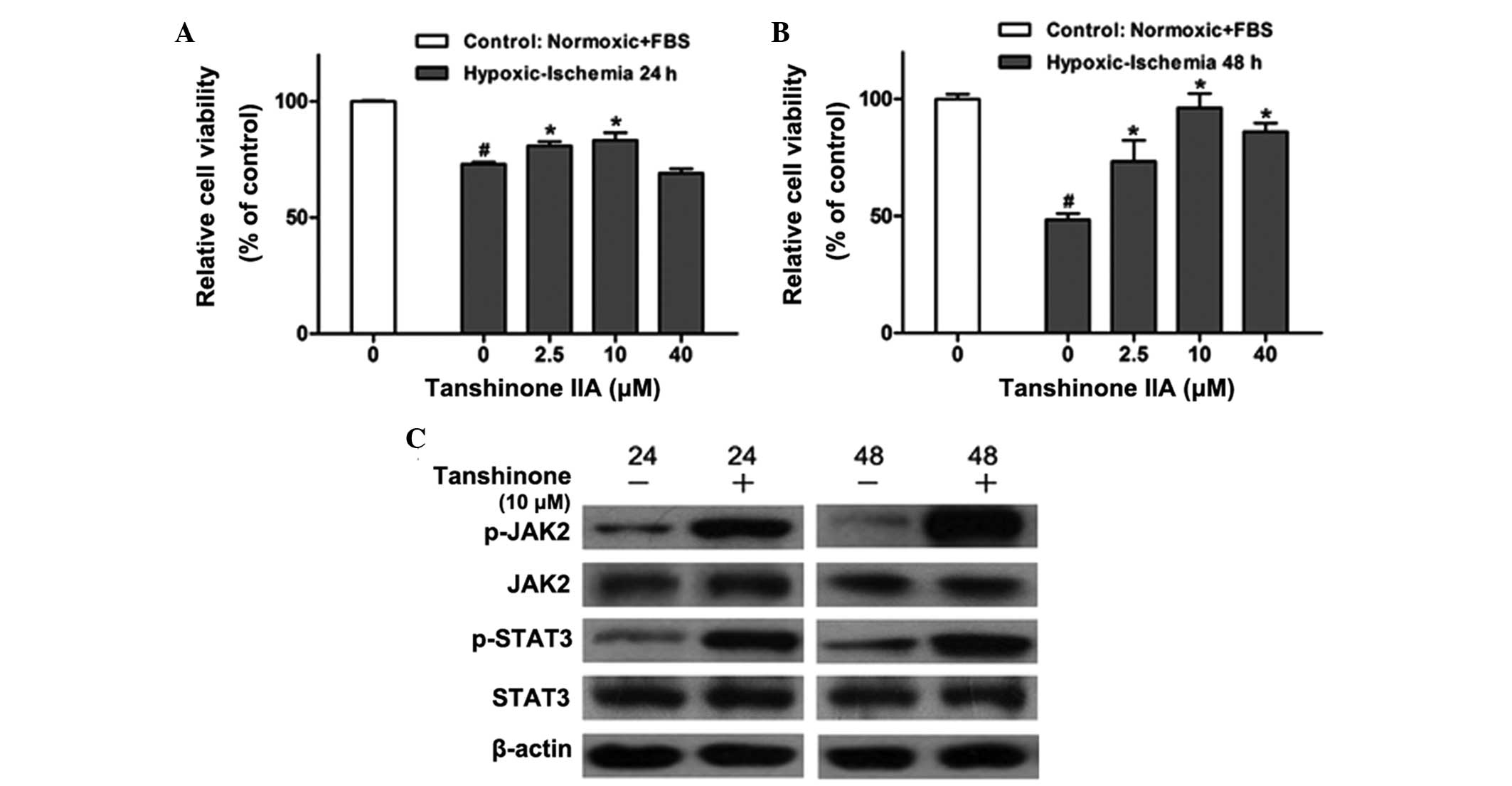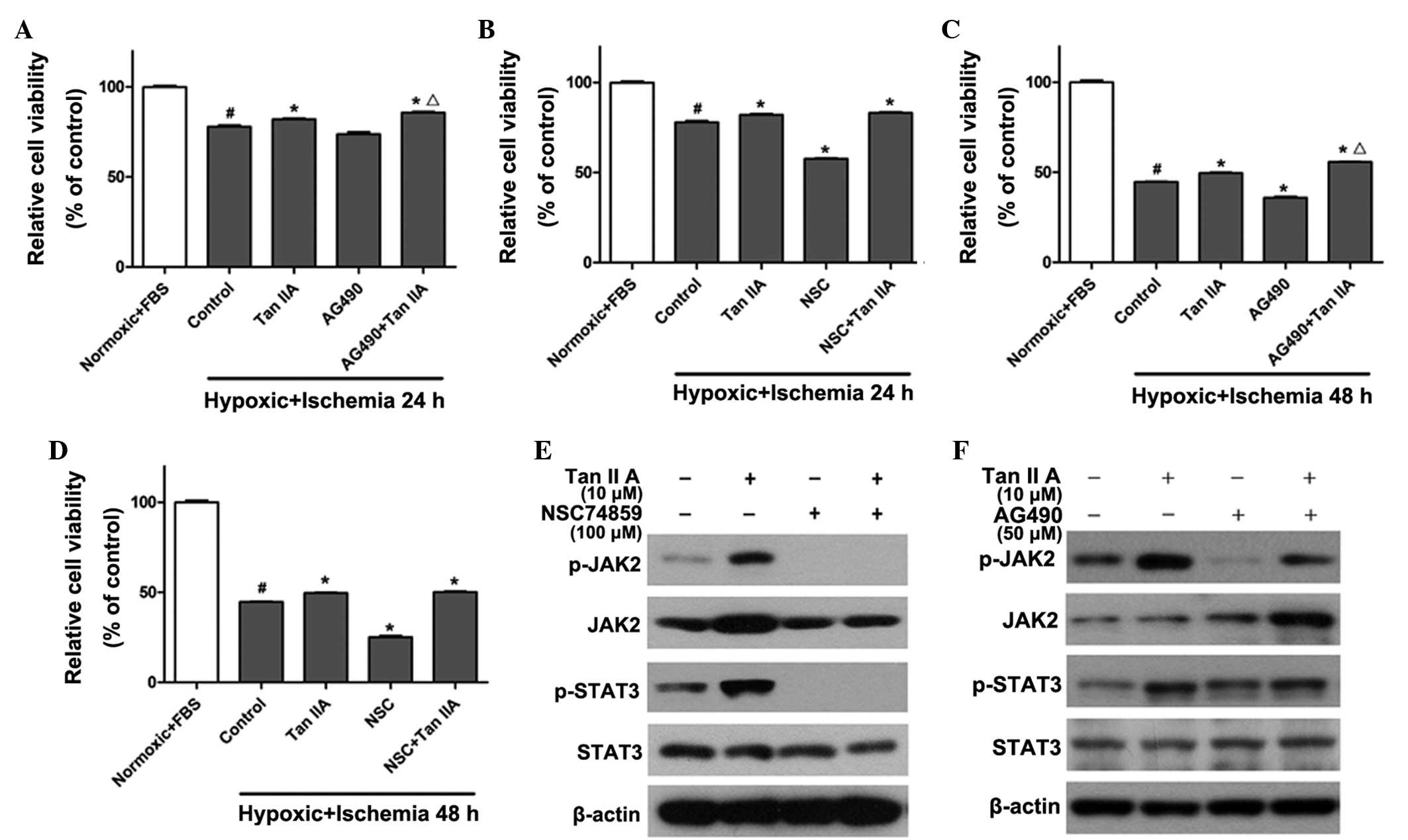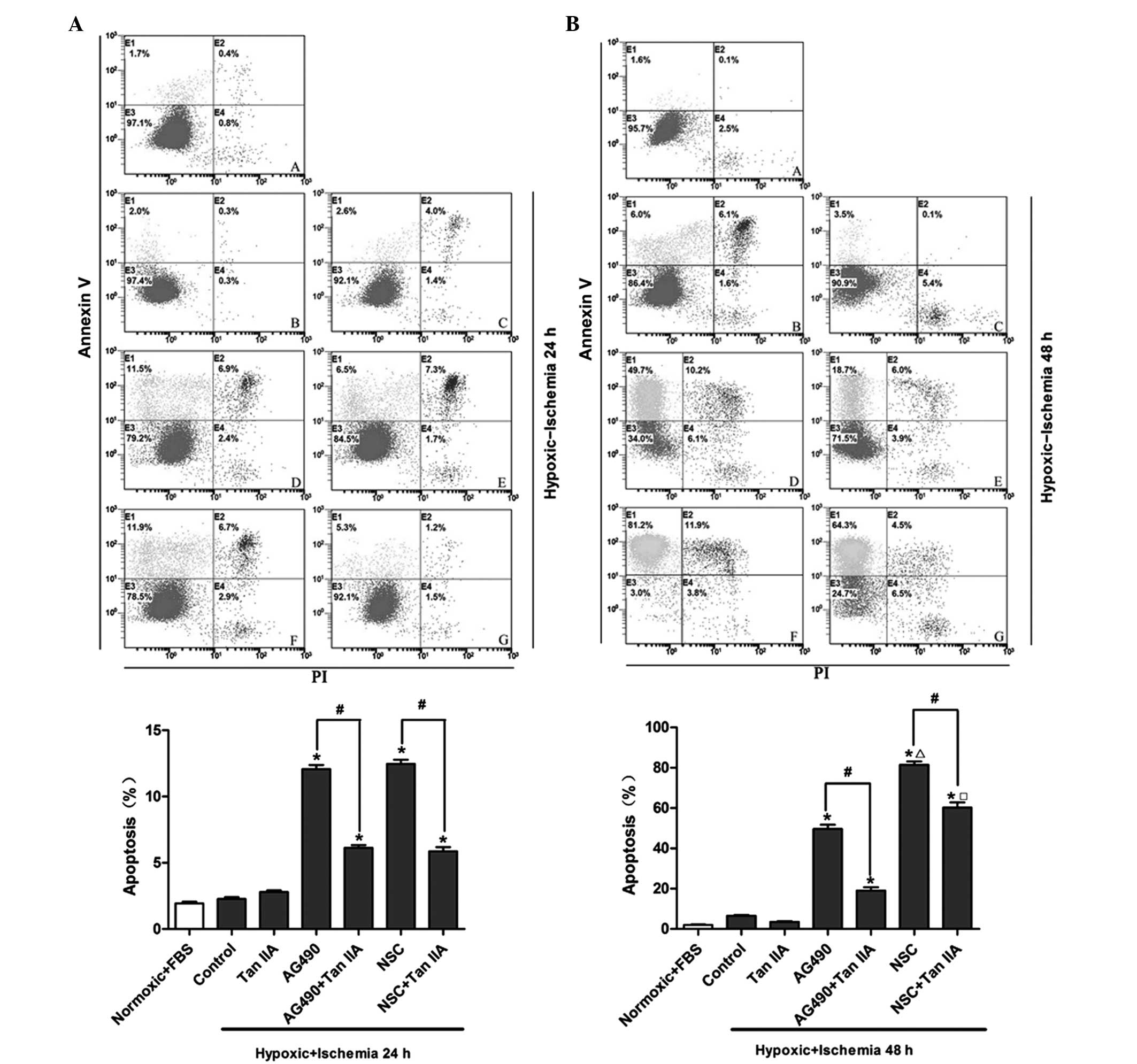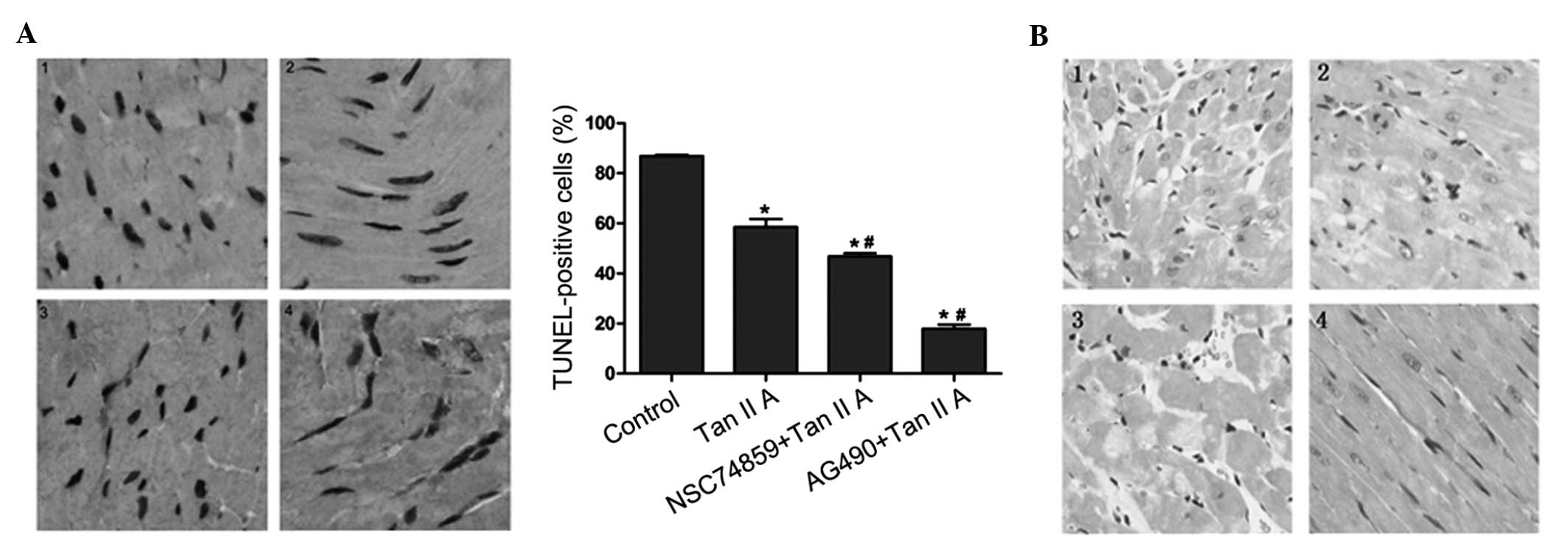Janus kinase/signal transducer and activator of transcription inhibitors enhance the protective effect mediated by tanshinone IIA from hypoxic/ischemic injury in cardiac myocytes
- Authors:
- Published online on: December 9, 2014 https://doi.org/10.3892/mmr.2014.3063
- Pages: 3115-3121
Abstract
Introduction
Ischemic reperfusion (IR) triggers the disturbance of microcirculation, a primary cause of cardiac failure and mortality following cardiac surgeries (1,2). Microcirculatory disturbances include endothelial cell injury, production of oxygen free radicals, energy supply reduction and myocardiocyte apoptosis (3).
Tanshinone IIA is an abundant lipophilic abietane diterpene compound which was isolated from Danshen (Salvia miltiorrhiza), a Traditional Chinese Medicine used for treating cardiovascular diseases (4,5). In addition, tanshinone IIA was reported to balance the superoxide dismutase content and the malondialdehyde concentration in injured myocytes through scavenging free acids and reducing lipid peroxidation, which therefore protected myocytes and vascular endothelial cells during the IR process (6,7). Furthermore, tanshinone IIA was found to markedly inhibit H2O2-induced oxidation in vitro, significantly inhibit IR-induced cardiomyocyte apoptosis via attenuation of morphological changes as well as reduce the percentage of terminal transferase 2′-deoxyuridine 5′-triphosphate (dUTP) nick end-labeling (TUNEL)-positive myocytes (8). However, it remains to be elucidated whether other signaling pathways are involved in the protective effects of tanshinone IIA on IR injury.
The Janus kinase/signal transducer and activator of transcription (JAK/STAT) signaling pathways regulate gene products involved in various cellular processes, including survival (9), apoptosis (10) and cell cycle progression (11); in addition, these pathways have been reported to have a vital role in inducing cardioprotection against IR injuries (10,12–15). Tanshinone IIA was found to inhibit JAK/STAT signaling and thereby induce apoptosis in cancer cells (16). The aim of the present study was to evaluate the effect of tanshinone IIA in combination with JAK2/STAT3 inhibitors on myocardial cells following the induction of hypoxic/ischemic injury in vitro and in vivo, as well as to elucidate the role of the JAK2/STAT3 signaling pathway in mediating the protective effects of tanshinone IIA.
Materials and methods
Cell culture and reagents
The H9c2 embryonic rat heart-derived cells were purchased from the Chinese Academy of Sciences (Shanghai, China) cultured in Dulbecco’s modified Eagle’s medium (DMEM) supplemented with 10% v/v fetal bovine serum (FBS) and 100 mg/ml penicillin/streptomycin at 37°C in a humidified atmosphere containing 5% CO2. Cells were maintained in serum-free culture and 100 nM deferoxamine to induce ischemia and hypoxic conditions. DMEM, FBS, antibiotics and deferoxamine were purchased from Invitrogen Life Technologies, Carlsbad, CA, USA.
Animals
Male Sprague-Dawley rats (age, six weeks; weight, 200–220 g) were purchased from the Chinese Academy of Sciences (Shanghai, China). Rats were housed in a specific pathogen-free laboratory and exposed to a 12-h light/dark cycle at 37°C with free access to food and water. The rats were randomly divided into four groups (10 rats per group). Rats in control group were treated with phosphate-buffered saline, and rats in the experimental groups were administrated intraperitoneally with Tanshinone IIA, or Tanshinone IIA in combination with NSC74859 or AG490. Myocardial ischemia was induced by exposing the heart through a left thoracic incision and placing a 6-0 silk suture around the left coronary artery. Following 30 min of ischemia, the slipknot was released to allow reperfusion. At the end of the experiment, the rats were sacrificed using anesthetic (sodium pentobarbital, 30 mg/kg body weight; Akorn, Lake Forest, IL, USA).
Cytotoxicity assay
Cytotoxic effects of tanshinone IIA or JAK/STAT inhibitors (Sigma-Aldrich, St. Louis, MO, USA) on H9c2 cells were evaluated using a Cell Counting Kit 8 (CCK-8; Dojindo, Kumamoto, Japan). Cells were seeded onto 96-well microplates at a density of 2×104 cells per well, preconditioned with hypoxia/ischemia (hypoxia, 5% O2) for 24 or 48 h and exposed to various concentrations of tanshinone IIA (0, 2.5, 10 and 40 μM) or JAK/STAT inhibitors AG490 and NSC74859 (50 and 100 μM, respectively) for 12 h. Cells were then incubated with CCK-8 solution at 37°C for 3 h. Optical density (OD) was measured at 450 nm using a MRX II microplate reader (Dynex Technologies, Inc., Chantilly, VA, USA). Cell viability was calculated as the percentage of viable cells in the drug-treated group versus that of the untreated control.
Flow cytometric analysis
Following treatment as above, cells (>1×106) were digested with 0.2% trypsin (BD Biosciences, Franklin Lakes, NJ, USA) and collected by centrifugation. Following washing twice with ice-cold phosphate-buffered saline, 10 μl Annexin V-fluorescein isothiocyanate and 5 μl propidium iodide (BD Biosciences) were added to a 85-μl cell suspension and incubated for 15 min in the dark. Stained cells were then analyzed by flow cytometry using a FACS Calibur system with Cell Quest software version 5.1 (BD Biosciences).
Western blot analysis
Following treatment as above, cells were homogenized in lysis buffer containing 50 mmol/l Tris-HCl (pH 7.3), 150 mmol/l NaCl, 5 mmol/l EDTA, 1 mmol/l dithiothreitol, 1% Triton X-100 and 1% protease inhibitor cocktail (Sigma-Aldrich). The lysates were centrifuged for 15 min at 12,000 × g and the resulting supernatant was transferred to a new tube and stored at −70°C. Protein concentrations were determined using a Bradford protein assay kit (Sigma-Aldrich) and proteins were separated using electrophoresis using 12% SDS-PAGE and transferred to nitrocellulose membranes (Sigma-Aldrich). The membranes were blocked for 1 h in Tris-buffered saline and Tween 20 (TBST; pH 7.6; Sigma-Aldrich) with 5% non-fat dry milk and then incubated overnight at 4°C with anti-mouse monoclonal antibodies against phospho-JAK2, phospho-STAT3, JAK2, STAT3 (dilution, 1:500) or β-actin (dilution, 1:1,000) purchased from Cell Signaling Technologies, Inc. (Beverly, MA, USA) followed by washes with TBST. The membranes were then probed with appropriate secondary antibodies (dilution, 1:5,000) at room temperature for 90 min, followed by washes with TBST. Protein bands were detected using a chemiluminescence kit (Sigma-Aldrich) and were quantified using the Quantity One software package (version 4.6.2; Bio-Rad Laboratories, UK). The result of the control group was defined as 100%.
In situ quantification of apoptotic cardiomyocytes
A portion of the myocardium from the mid-left ventricle of the middle slices was fixed in 4% formalin (Sigma-Aldrich). The apoptotic rate of the myocardial cells was analyzed using terminal deoxynucleotidyl transferase dUTP nick end labeling (TUNEL) staining using an in situ cell death detection kit (Roche, Basel, Switzerland). A double-staining technique was used; TUNEL staining was used to quantify apoptotic cell nuclei and DAPI staining (Sigma-Aldrich) was used to quantify the total myocardial cell nuclei. TUNEL-positive cells with green nuclear staining and all cells with blue nuclear DAPI staining were counted within five randomly selected fields under high-power magnification (DM-2500; Leica Microsystems, Wetzlar, Germany). The index of apoptosis was expressed as the ratio of positively stained apoptotic myocytes to the total number of myocytes counted ×100%.
Histomorphological analysis
Following experimental preconditioning and measurement of hemodynamics, the hearts of mice were quickly removed and dissected into transverse slices from apex to base and processed for histology. Subsequently, the hearts were fixed in a 10% formalin solution (Sigma-Aldrich) for 24 h, embedded in paraffin wax (Sigma-Aldrich). After deparrafinization with xylene, the wax was serially sectioned at 7 μm using routine protocols (17). For the histomorphological analysis, the sections were stained with hematoxylin-eosin (HE; Sigma-Aldrich) and examined using a light microscope (BX40; Olympus, Tokyo, Japan).
Statistical analysis
Values are presented as the mean ± standard error of the mean. Group comparisons were performed using analysis of variance with SPSS 13.0 software (SPSS, Inc. Chicago, IL, USA). P<0.05 was considered to indicate a statistically significant difference between values.
Results
Tanshinone IIA protects H9c2 rat myoblast cells from hypoxic ischemia-induced injury and reduced viability
In order to determine the effect of tanshinone IIA on H9c2 cells, the H9c2 rat myoblast cell line was preconditioned with hypoxia/ischemia (24 and 48 h) and treated with various concentrations (0, 2.5, 10 or 40 μM) of tanshinone IIA for 12 h. A CCK8 assay was then performed (Fig. 1A and B). Hypoxic/ischemic injury significantly reduced the viability of H9c2 cells; however, following treatment with tanshinone IIA, cell viability was markedly increased in a dose-dependent manner compared with that of the untreated group, with the most potent protective effects observed with 10 μM tanshinone IIA. Furthermore, the protective effects of tanshinone IIA were more prominent following 48 h hypoxic/ischemia preconditioning compared to those in the group preconditioned for 24 h.
Tanshinone IIA activates the JAK2/STAT3 pathway in H9c2 cells
The JAK-STAT pathway is activated by stress (9,18), including hypoxic/ischemic injury, which was first confirmed in a rodent model study (19). In order to verify whether the protective mechanisms of tanshinone IIA proceeded via the JAK2/STAT3 signaling pathway, the effects of tanshinone IIA on JAK2 and STAT3 activation were examined using western blot analysis. As shown in Fig. 1C, 10 μM tanshinone IIA significantly upregulated the phosphorylation of JAK2 and STAT3 following 24 and 48 h of hypoxia/ischemia treatment, which was consistent with the results of the CCK-8 assay above.
JAK2 inhibitors promote the myocardial protective effects of tanshinone IIA from hypoxic-ischemic injury
In order to further determine whether the JAK2/STAT3 signaling pathway was responsible for the protective effect of tanshinone IIA, the JAK2 inhibitor AG490 (20) and the STAT3 inhibitor NSC74859 (17) were used to treat H9c2 cells alone (50 and 100 μM, respectively) or in combination with 10 μM tanshinone IIA. As shown in Fig. 2, the viability of H9c2 cells was significantly reduced to 73±1.2% in the 24-h hypoxic ischemia-preconditioned group (Fig. 2A and B) and 44±2.3% in the 48-h hypoxic ischemia-preconditioned (Fig. 2C and D) compared to that of the normoxic and FBS groups (P<0.05). Tanshinone IIA reversed the injury and slightly restored cell viability to 80±1.1% and 49±1.4% in the groups pre-conditioned with 24 and 48 h hypoxic ischemia, respectively, which was significantly increased compared to that of the control group (P<0.05). Conversely, AG490 and NSC74859 reduced cell viability by 8±1.4% (Fig. 2A and C) and 13±2.7% (Fig. 2B and D) in the groups preconditioned with 24 and 48 h hypoxic ischemia, respectively, compared to that of the control group (P<0.05). Of note, co-administration of the JAK inhibitor AG490 with tanshinone IIA restored cell viability by 5.2±1.9% (Fig. 2A and C) in comparison with the tanshinone IIA only treatment group (P<0.05); however, no significant effects were observed following co-administration of tanshinone IIA with the STAT3 inhibitor NSC74859 (Fig. 2B and D). In addition, tanshinone IIA treatment significantly increased the phosphorylation level of JAK2 and STAT3. The level of p-JAK2 was inhibited following treatment with NSC74859 alone or NSC74859 combined with tanshinone IIA (Fig. 2E). As shown in Fig. 2F, AG490 suppressed the activation of JAK2 and STAT3; however, co-administration of tanshinone IIA and AG490 restored the phosphorylation level of JAK2 and STAT3. This therefore demonstrated that contrary to the expected result, the co-application of AG490 and tanshinone IIA did not eliminate the protective effect of tanshinone IIA, but further restored myocardial cell viability following the induction of hypoxic ischemia; furthermore, these results indicated that AG490 may affect the protective function of tanshinone IIA via inhibition of the JAK/STAT pathway.
Tanshinone IIA reverses the augmentation effect of JAK2/STAT3 inhibitors on apoptosis in H92C cells
Flow cytometric analysis was performed in order to investigate the effects of tanshinone IIA and JAK2/STAT3 inhibitors on hypoxic ischemia-induced cardiomyocyte apoptosis following 24 (Fig. 3A) and 48 h (Fig. 3B) of hypoxic ischemia preconditioning. Following treatment with the JAK inhibitor AG490, the percentage of hypoxic ischemia-induced apoptotic cells significantly increased from 2.0% to 11.5% and from 6.0 to 49.7% following 24 and 48 h of hypoxic ischemia preconditioning, respectively (P<0.05). Tanshinone IIA significantly reduced the exacerbation of hypoxic ischemia-induced apoptosis mediated by AG490 from 11.5 to 6.5% and from 49.7 to 18.7% following 24 and 48 h of hypoxic ischemia preconditioning, respectively (P<0.05). Similarly, the STAT3 inhibitor NSC74859 significantly increased the percentage of hypoxic ischemia-induced apoptotic cells from 2.0% to 11.9% and from 6.0 to 81.2% following 24 and 48 h of hypoxic ischemia preconditioning, respectively (P<0.05); however, co-administration of tanshinone IIA with NSC74859 markedly reduced the exacerbation of hypoxic ischemia-induced apoptosis from 11.5 to 5.3% and 81.2 to 64.3% following 24 and 48 h of hypoxic ischemia preconditioning, respectively (P<0.05).
Effect of tanshinone IIA on apoptosis
In order to verify the combined effects of tanshinone IIA and JAK/STAT inhibitors in vivo, tanshinone IIA and JAK/STAT inhibitors were administrated to normal mice following hypoxic/ischemia treatment. TUNEL-staining was used to identify apoptotic cells in the myocardium of control and treated mice (Fig. 4A). The number of TUNEL-positive cells observed was reduced in mice treated with tanshinone IIA; this effect was markedly enhanced in mice treated tanshinone IIA and AG490 combined (P<0.05). In addition, co-treatment with NSC74859 slightly decreased the percentage of TUNEL-positive cells compared with that in the tanshinone IIA group.
JAK2 inhibitor enhances the ishemia/reperfusion injury alleviating effect of tanshinone IIA in vivo
In order to demonstrate the pathological effects of tanshinone IIA and JAK/STAT inhibitors on ischemia/reperfusion in vivo, mice underwent hypoxic-ischemia preconditioning and treatment with the respective drugs, then histological sections of the myocardium were obtained and stained with HE (Fig. 4B). Staining revealed that ischemia/reperfusion injury was markedly alleviated in the tanshinone IIA group compared with that in the control group; in addition, these beneficial effects were observed to be enhanced by co-treatment with AG490. However, no difference was observed between the ischemia/reperfusion injury in the tanshinone IIA group and the group threated with tanshinone IIA and NSC74859 combined.
Discussion
According to Traditional Chinese Medicine (TCM), tanshinone IIA, a derivative of phenanthrenequinone, enhances blood circulation and exhibits protective effects on the heart (4,21–23). Hypoxia/ischemia induces the disturbance of microcirculation, which leads to numerous adverse effects, including endothelial cell injury, energy supply reduction and myocardiocyte apoptosis (3). Previous studies have reported that tanshinone IIA markedly inhibited H2O2-induced cardiomyocyte apoptosis (24) as well as serum withdrawal- or ethanol- induced apoptosis in cultured PC12 cells (25). The results of the present study demonstrated that tanshinone IIA protected myocardial cells from hypoxia/ischemia-induced injury, as shown by CCK-8 assays and flow cytometric analysis; in addition, the effects of tanshinone IIA treatment were more marked following prolonged hypoxia/ischemia pretreatment from 24 to 48 h.
The JAK-STAT pathway has previously been confirmed to be involved in cardiac apoptosis (26); as was first reported by a study on rat models of myocardial infarction, activation of the JAK1/STAT3 pathway limits apoptosis (27). The results of the present study suggested that tanshinone IIA treatment increased phosphorylation of JAK/STAT3, which may be the mechanism by which tanshinone IIA exerts its cardiomyocyte protective and antiapoptotic effects. Previous studies have demonstrated that activated STAT3 has an essential role in ischemic injury (3,4); in addition, in these studies, the nonspecific JAK2 inhibitor AG490 and the specific STAT3 inhibitor NSC 74859 were administered in order to attenuate JAK/STAT3 activation prior to ischemic insult. AG-490 was reported to suppress the phosphorylation of STAT3, which resulted in increased caspase-3 activity and B cell lymphoma-associated X protein expression, concomitant with an increase in TUNEL-positive myocytes; this therefore indicated that JAK/STAT signaling may have antiapoptotic effects (28). Similarly, NSC74859 was reported to partially inhibit STAT3 dimerization and decrease target gene activation to reduce cell survival (29). In concurrence with these previous studies, the results of the present study demonstrated that AG490 and NSC74859 enhanced apoptosis and reduced cell viability following hypoxic/ischemic injury; in addition, tanshinone IIA reversed the exacerbation of hypoxia/ischemia-induced apoptosis mediated by JAK/STAT3 inhibitors.
Contrary to the expected results, co-administration of tanshinone IIA and JAK/STAT3 inhibitors augmented the myocardial protective function of tanshinone IIA against hypoxic/ischemic injury in H9c2 cells in vitro as well as in mouse models in vivo. In addition, AG490 exhibited a more potent synergistic effect with tanshinone IIA than NSC74859. These results therefore suggested that the JAK/STAT3 signaling pathway had an important biphasic effect on the cardiac protection by tanshinone IIA from ischemia/reperfusion injury. One possible explanation for this is that JAK2 may activate STAT1 as well as STAT3; it has been previously reported that ischemia/reperfusion injury activated STAT1, which exerted a proapoptotic effect, whereas STAT3 had an antiapoptotic effect and antagonized the effects of STAT1 (30). This putative proapoptotic role of STAT1 in cardiomyocytes would be consistent with that observed in non-cardiac cells (31). In addition, the effects of tanshinone IIA may involve the STAT1 and STAT3 pathways, and the crosstalk between them determines the pharmacodynamic effects. It was previously reported that tanshinone IIA inhibited JAK2/STAT5 signaling, which induced apoptosis in cancer cells (16); in addition, AG920 was found to stimulate STAT5 signaling, which protected cells from apoptosis, therefore forming a negative feedback loop. Another possible explanation is that AG92, as a nonspecific inhibitor of JAK, initiated other pathways which were not involved in JAK2/STAT3 signaling. The exact mechanism underlying the effect of tanshinone IIA on ischemia/reperfusion remains elusive and further studies are required in order to elucidate the precise mechanisms by which JAK2/STAT3 inhibitors exert their synergistic action with tanshinone IIA. However, co-administration of JAK2/STAT3 pathway inhibitors and tanshinone IIA may be a potential novel treatment option for myocardial ischemia reperfusion in future clinical therapy.
In conclusion, the results of the present study demonstrated that JAK2/STAT3 inhibitors enhanced the protective effect of tanshinone IIA on cardiac myocytes following hypoxia/ischemia-induced injury, suggesting that JAK2/STAT3 inhibitors have the potential to be used for treating ischemia-reperfusion injury in combination with tanshinone IIA.
Acknowledgements
The present study was supported by general project funds of the Administration of Traditional Chinese Medicine of Zhejiang province (no. 2012ZA015).
References
|
Liao X, Wang L, Yang C, et al: Cyclooxygenase mediates cardioprotection of angiotensin-(1–7) against ischemia/reperfusion-induced injury through the inhibition of oxidative stress. Mol Med Rep. 4:1145–1150. 2011.PubMed/NCBI | |
|
Ramzy D, Rao V and Weisel RD: Clinical applicability of preconditioning and postconditioning: the cardiothoracic surgeons’s view. Cardiovasc Res. 70:174–180. 2006. View Article : Google Scholar : PubMed/NCBI | |
|
Wang N, Min X, Li D, He P and Zhao L: Geranylgeranylacetone protects against myocardial ischemia and reperfusion injury by inhibiting high-mobility group box 1 protein in rats. Mol Med Rep. 5:521–524. 2012. | |
|
Zhou L, Zuo Z and Chow MS: Danshen: an overview of its chemistry, pharmacology, pharmacokinetics, and clinical use. J Clin Pharm. 45:1345–1359. 2005. View Article : Google Scholar | |
|
Shang QH, Xu H and Huang L: Tanshinone IIA: a promising natural cardioprotective agent. Evid Based Complement Alternat Med. 7:1120–1126. 2012. | |
|
Luo Y, Xu DQ, Dong HY, Zhang B, Liu Y, Niu W, Dong MQ and Li ZC: Tanshinone IIA inhibits hypoxia-induced pulmonary artery smooth muscle cell proliferation via Akt/Skp2/p27-associated pathway. PLoS One. 8:e567742013. View Article : Google Scholar : PubMed/NCBI | |
|
Fu J, Huang H, Liu J, Pi R, Chen J and Liu P: Tanshinone IIA protects cardiac myocytes against oxidative stresstriggered damage and apoptosis. Eur J Pharmacol. 568:213–221. 2007. View Article : Google Scholar : PubMed/NCBI | |
|
Zhou G, Jiang W, Zhao Y, et al: Sodium tanshinone IIA sulfonatemediates electron transfer reaction in rat heartmitochondria. Biochem Pharmacol. 65:51–57. 2003. View Article : Google Scholar | |
|
Koppikar P, Bhagwat N, Kilpivaara O, et al: Heterodimeric JAK-STAT activation as a mechanism of persistence to JAK2 inhibitor therapy. Nature. 89:155–159. 2012. View Article : Google Scholar | |
|
Zhang S, Liu X, Goldstein S, et al: Role of the JAK/STAT signaling pathway in the pathogenesis of acute myocardial infarction in rats and its effect on NF-κB expression. Mol Med Rep. 7:93–98. 2013. | |
|
Lange CM, Gouttenoire J, Duong FH, et al: Vitamin D receptor and Jak-STAT signaling crosstalk results in calcitriol-mediated increase of hepatocellular response to IFN-α. J Immunol. 192:6037–6044. 2014. View Article : Google Scholar : PubMed/NCBI | |
|
Zgheib C, Kurdi M, Zouein FA, et al: Acyloxy nitroso compounds inhibit LIF signaling in endothelial cells and cardiac myocytes: evidence that STAT3 signaling is redox-sensitive. PLoS One. 7:e433132012. View Article : Google Scholar : PubMed/NCBI | |
|
Bolli R, Dawn B and Xuan YT: Role of the JAK-STAT pathway in protection against myocardial ischemia/reperfusion injury. Trends Cardiovasc Med. 13:72–79. 2003. View Article : Google Scholar : PubMed/NCBI | |
|
Yu HC, Qin HY, He F, et al: Canonical notch pathway protects hepatocytes from ischemia/reperfusion injury in mice by repressing reactive oxygen species production through JAK2/STAT3 signaling. Hepatology. 54:979–988. 2011. View Article : Google Scholar : PubMed/NCBI | |
|
Smith RM, Suleman N, Lacerda L, Opie LH, Akira S, Chien KR and Sack MN: Genetic depletion of cardiac myocyte STAT3 abolishes classical preconditioning. Cardiovasc Res. 63:611–616. 2004. View Article : Google Scholar : PubMed/NCBI | |
|
Jung JH, Kwon TR, Jeong SJ, et al: Apoptosis induced by Tanshinone IIA and Cryptotanshinone is mediated by distinct JAK/STAT3/5 and SHP1/2 signaling in chronic myeloid leukemia K562 cells. Evid Based Complement Alternat Med. 2013:8056392013. View Article : Google Scholar : PubMed/NCBI | |
|
Siddiquee K, Zhang S, Guida WC, et al: Selective chemical probe inhibitor of Stat3, identified through structure-based virtual screening, induces antitumor activity. Proc Natl Acad Sci USA. 104:7391–7396. 2007. View Article : Google Scholar : PubMed/NCBI | |
|
Mertens C and Darnell JE Jr: SnapShot: JAK-STAT signaling. Cell. 131:612–618. 2007. View Article : Google Scholar : PubMed/NCBI | |
|
Negoro S, Kunisada K, Tone E, et al: Activation of JAK/STAT pathway transduces cytoprotective signal in rat acute myocardial infarction. Cardiovasc Res. 47:797–805. 2000. View Article : Google Scholar : PubMed/NCBI | |
|
Grandage VL, Everington T, Linch DC and Khwaja A: Gö6976 is a potent inhibitor of the JAK 2 and FLT3 tyrosine kinases with significant activity in primary acute myeloid leukaemia cells. Br J Haematol. 135:303–316. 2006. View Article : Google Scholar : PubMed/NCBI | |
|
Chan P, Liu IM, Li YX, Yu WJ and Cheng JT: Antihypertension induced by tanshinone II A isolated from the roots of salvia miltiorrhiza. Evid Based Complement Alternat Med. 12:234–239. 2011. | |
|
Li YS, Wang ZH and Wang J: Effect of tanshinone IIA on angiotensin receptor in hypertrophic myocardium of rats with pressure over-loading. Chin J Integr Med. 28:632–636. 2008.(In Chinese). | |
|
Feng J and Zheng Z: Effect of sodium tanshinone IIA sulfonate on cardiac myocyte hypertrophy and its underlying mechanism. Chin J Integr Med. 14:197–201. 2008. View Article : Google Scholar : PubMed/NCBI | |
|
Yang R, Liu A, Ma X, et al: Sodium tanshinone IIA sulfonate protects cardiomyocytes against oxidative stress-mediated apoptosis through inhibiting JNK activation. J Cardiovasc Pharmacol. 51:396–401. 2008. View Article : Google Scholar : PubMed/NCBI | |
|
Meng XF, Zou XJ, Peng B, et al: Inhibition of ethanol-induced toxicity by tanshinone IIA in PC12 cells. Acta Pharmacol Sin. 27:659–664. 2006. View Article : Google Scholar : PubMed/NCBI | |
|
Borensztejn A, Boissoneau E, Fernandez G, Agnès F and Pret AM: JAK/STAT autocontrol of ligand-producing cell number through apoptosis. Development. 140:195–204. 2013. View Article : Google Scholar | |
|
Obana M, Maeda M, Takeda K, et al: Therapeutic activation of signal transducer and activator of transcription 3 by interleukin-11 ameliorates cardiac fibrosis after myocardial infarction. Circulation. 121:684–691. 2010. View Article : Google Scholar : PubMed/NCBI | |
|
Negoro S, Kunisada K, Tone E, et al: Activation of JAK/STAT pathway transduces cytoprotective signal in rat acute myocardial infarction. Cardiovasc Res. 47:797–805. 2000. View Article : Google Scholar : PubMed/NCBI | |
|
Siddiquee K, Zhang S, Guida WC, et al: Selective chemical probe inhibitor of Stat3, identified through structure-based virtual screening, induces antitumor activity. Proc Natl Acad Sci USA. 104:7391–7396. 2007. View Article : Google Scholar : PubMed/NCBI | |
|
Stephanou A, Brar BK, Scarabelli TM, et al: Ischemia-induced STAT-1 expression and activation play a critical role in cardiomyocyteapoptosis. J Biol Chem. 275:10002–10008. 2000. View Article : Google Scholar : PubMed/NCBI | |
|
Kumar A, Kumar A, Michael P, et al: Human serum from patients with septic shock activates transcription factors STAT1, IRF1, and NF-κB and induces apoptosis in human cardiac myocytes. J Biol Chem. 280:42619–42626. 2005. View Article : Google Scholar : PubMed/NCBI |













